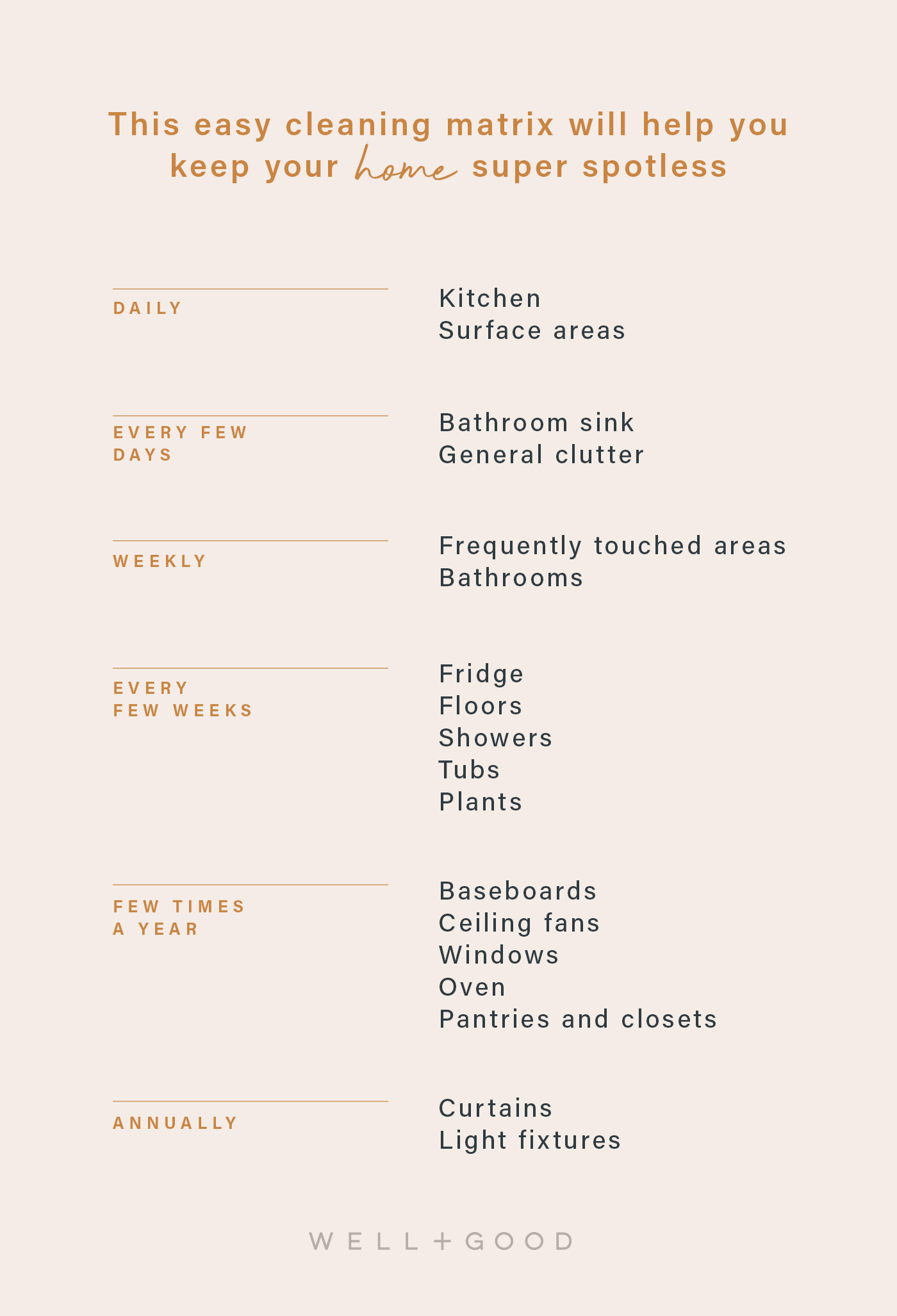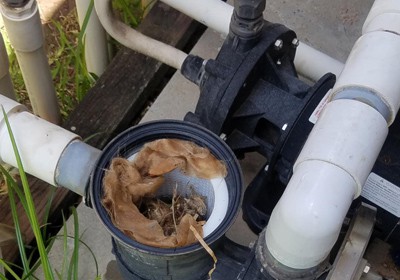Mop your floors at least once a week or more frequently in high-traffic areas. Adjust this frequency based on activity level and floor type.
Maintaining clean floors is essential for a hygienic home environment. The cleanliness of your floors can significantly impact the overall feel and healthfulness of your living space. Regular mopping removes dirt, dust, and potential allergens, contributing to better indoor air quality.
For households with pets, children, or allergy sufferers, keeping a consistent mopping schedule is even more crucial. The type of flooring you have also dictates mopping frequency; for instance, hardwood may require less moisture and gentler care compared to tile or linoleum. Embrace a routine that fits your lifestyle and flooring needs, ensuring your surfaces are not just visibly clean but also hygienically maintained.
:max_bytes(150000):strip_icc()/how-often-mop-floors-GettyImages-761856731-df9265fdc08e4f8f91fc7f275051dc01.jpg)
Credit: www.realsimple.com
The Importance Of Regular Mopping
The Importance of Regular Mopping cannot be overstated. Clean floors make for a healthier, more inviting space. They also last longer. Knowing how often to mop floors is key to maintaining an ideal home environment.
Maintaining Cleanliness
Regular mopping eliminates dirt, grime, and allergens. These unwanted guests build up over time. They can affect air quality and overall cleanliness. A clean floor reflects a well-kept home. It invites guests to relax and feel comfortable.
Boldly mark your calendar for weekly mopping. This routine keeps floors in pristine condition. Stick to this schedule to ensure a consistently clean surface.
- Spot clean spills immediately to prevent stains.
- Use the right cleaner for your floor type.
- Rotate heavy cleaning areas to maintain thoroughness.
Extending Floor Life
Mopping plays a crucial role in extending the life of your floors. Dirt acts like sandpaper. It wears down surfaces with each step. Regular mopping removes this abrasive material.
Protect your investment with a mop routine. Hardwood, tile, or laminate, each needs care to last. Avoid replacing floors prematurely. Mop them regularly instead.
| Floor Type | Cleaning Frequency |
|---|---|
| Hardwood | Once a week |
| Tile | Twice a week |
| Laminate | Every other week |
Adjust the frequency based on household activity. Homes with kids or pets might need more frequent mopping. Use gentle, effective cleaners to preserve floor finish and quality.
Factors Influencing Mopping Frequency
Keeping floors clean is essential for a tidy home. Yet, the frequency of mopping can vary greatly. Many factors play a role in determining how often this task should be done. Understanding these can help maintain your floors effectively.
Traffic And Use
The number of people walking over a surface impacts cleanliness. High-traffic areas like kitchens and hallways need more frequent mopping. Look for signs of dirt or grime as a cue to mop these spaces.
Type Of Flooring
Different flooring materials require different care. Tile and vinyl withstand water well, so you can mop often. Hardwood, however, needs less mopping to prevent water damage. Always check the manufacturer’s instructions.
Presence Of Pets And Children
Pets and children can bring in more dirt. They may also cause spills. Floors in homes with little ones or furry friends may need mopping several times a week. Use gentle cleaners to keep the area safe for them.
| Factor | Suggested Mopping Frequency |
|---|---|
| High Traffic | 2-3 times a week |
| Low Traffic | Once a week |
| Pets & Children | 2-4 times a week |
| Hardwood Floors | Every 2 weeks |
Remember to adjust these guidelines based on your home’s specific needs. Always prioritize cleanliness and hygiene to ensure a healthy living environment.
Mopping Best Practices
Maintaining clean floors is essential for a healthy home. The question is not just how often to mop, but how to do it effectively. Here are some mopping best practices to keep floors sparkling clean.
Choosing The Right Mop
Not all mops are created equal. For effective mopping, select a mop that suits your flooring type.
- Flat mops are great for hardwood and laminate.
- String mops work well on tile and textured floors.
- Microfiber mops attract dust and are gentle on all surfaces.
Selecting Cleaning Solutions
Choosing the right cleaner is crucial. It ensures that floors are not only clean but remain undamaged.
| Floor Type | Cleaning Solution |
|---|---|
| Hardwood | PH-neutral, water-based cleaners |
| Tile | Diluted vinegar or specialized tile cleaners |
| Laminate | Gentle, soap-free products |
Always follow the manufacturer’s instructions. Test any new solution on a small, inconspicuous area first.

Credit: www.wellandgood.com
Daily Vs. Weekly Mopping
When it comes to keeping floors clean, the dilemma of daily vs. weekly mopping often surfaces. A sparkling floor can transform the feel of a home. Yet, how often should you mop? The answer isn’t one-size-fits-all. It depends on your home’s foot traffic, floor type, and lifestyle.
Assessing Your Needs
Consider the room’s use. High-traffic areas like kitchens may need more frequent mopping. Homes with pets or children may also require daily mopping to address spills and debris.
Factor in the floor type. Hardwood floors are more sensitive and may not withstand daily mopping, while tile floors could handle it.
Creating A Routine
Creating a mopping routine ensures clean floors without overdoing it. Here’s a simple guide to get you started:
| Area | Daily | Weekly |
|---|---|---|
| Kitchen | Spot clean spills | Full mop |
| Bathrooms | Address wet spots | Full mop |
| Living Areas | Vacuum or sweep | Mop if needed |
Stick to your routine and adjust as needed. Your floors will thank you!
Seasonal Considerations For Mopping
Understanding the right mopping frequency can be tricky. Seasons change, and so do your home’s cleaning needs. Let’s dive into how seasons impact your mopping routine.
Dealing With Mud And Snow
Winter brings snow, slush, and mud. These can dirty your floors more often. Your mopping schedule should adjust to these changes.
- Place mats at every entrance to catch most of the dirt.
- Mop high-traffic areas at least twice a week.
- Use hot water and floor cleaner to dissolve salt and grime.
Summer Dirt And Allergens
Summer means more dust and allergens. Your floors can tell.
- Mop once a week to keep floors fresh.
- Microfiber mops trap dirt and reduce allergens.
- Consider a gentle cleanser to prevent floor damage.
Remember, clean floors contribute to a healthy home. Adjust your mopping to match the season, and enjoy a cleaner, happier space year-round.
Addressing Spills And Stains
Clean floors make a happy home, but spills and stains can happen anytime. Knowing how to tackle these messes quickly and efficiently is key to maintaining spotless floors. Let’s dive into the best strategies for dealing with unexpected spills.
Immediate Action
Time is of the essence when dealing with spills. The quicker you act, the less likely a stain will set. Here’s what to do:
- Blot liquid spills gently with a clean cloth or paper towel. Avoid rubbing, as it can spread the stain.
- For solid spills, use a spoon or scraper to lift away the substance carefully.
- Apply a suitable cleaner to the affected area and follow the product’s instructions.
- Rinse with water if necessary, and dry the area completely to prevent moisture damage.
Preventative Measures
Preventing stains before they occur is the best strategy. Keep your floors looking great:
- Place mats at entrances to catch dirt and spills from shoes.
- Use protective pads under furniture to avoid scratches and scuffs.
- Clean floors regularly to remove dirt that can become ground in.
- Keep cleaning supplies handy for quick spill response.
By taking these steps, your floors will stay clean longer, and you’ll be ready for any spills that come your way.
The Role Of Professional Cleaning
The Role of Professional Cleaning can be a game-changer in maintaining your home’s hygiene. Regular mopping keeps your floors sparkling and extends their life. Yet, sometimes our busy schedules make it tough to keep up with cleaning. This is where professional cleaners step in.
When To Hire Help
Deciding on the right time to hire professional cleaning services depends on several factors. Consider these:
- Size of your home: Larger spaces may require more frequent professional cleaning.
- Level of activity: Homes with kids, pets, or lots of foot traffic might need extra cleaning help.
- Special occasions: Events or holidays often call for a deeper clean.
- Health concerns: Those with allergies or respiratory issues benefit from regular, professional mopping.
Cost Vs. Convenience
Weighing the cost against convenience is crucial when considering professional floor cleaning. Here’s a quick comparison:
| Cost | Convenience |
|---|---|
| Professional services may seem pricey. | Saves time and effort, providing peace of mind. |
| Regular appointments can add up over time. | Ensures a consistently clean environment. |
| Some services offer packages for savings. | Custom schedules fit your lifestyle and needs. |
Assess your budget and schedule to decide if the benefits of hiring professionals outweigh the costs. Remember, clean floors contribute to a healthy, happy home.
Health And Hygiene Benefits
Clean floors are not just about appearance. Regular mopping can lead to a healthier home environment. Let’s dive into how mopping benefits your health.
Reducing Allergens
Dust, pollen, and pet dander are common allergens that accumulate on floors. These can trigger allergies and respiratory issues.
- Mopping captures these particles, reducing their presence.
- Weekly mopping can greatly improve indoor air quality.
- Use a damp mop to trap allergens rather than spreading them.
Preventing Illness
Floors can harbor bacteria and viruses. These pathogens can spread illnesses.
| Method | Frequency | Benefit |
|---|---|---|
| Regular Mopping | Weekly | Reduces germ buildup |
| Disinfectant Use | As needed | Kills bacteria and viruses |
Disinfect high-traffic areas to prevent the spread of illness.
Eco-friendly Mopping Options
Clean floors contribute to a healthy home. Yet, many wonder about the frequency of mopping. Even more, today’s eco-conscious homeowners seek greener cleaning methods. Let’s explore some eco-friendly mopping options that keep floors sparkling without harming the planet.
Sustainable Products
Choosing sustainable mopping tools is a step towards greener cleaning. Opt for mops made from recycled materials or those with reusable, washable pads. These products reduce waste and offer a long-term solution for eco-friendly home maintenance.
- Microfiber mops: Efficient in cleaning and reusable.
- Bamboo handles: Durable and from a renewable resource.
- Recycled plastic components: Lessen environmental impact.
Natural Cleaning Solutions
Natural cleaning solutions safeguard your family’s health and the environment. Simple ingredients like vinegar and baking soda effectively clean floors without toxic chemicals. These natural cleaners are safe for kids and pets, and they keep waterways clean.
| Ingredient | Use |
|---|---|
| Vinegar | Cuts through grease and grime. |
| Baking Soda | Removes tough stains. |
| Essential Oils | Adds a fresh scent and antibacterial properties. |
Combine these ingredients with hot water for an effective, eco-friendly mop solution. Remember to spot test on flooring before full application to ensure compatibility.
Common Mopping Mistakes To Avoid
Keeping your floors clean is crucial for a tidy home. Yet, it’s easy to make mistakes while mopping. Know what to avoid for sparkling floors.
Overwetting The Floor
Too much water damages floors, especially wood and laminate. It can cause swelling, warping, and mold growth. Follow these tips:
- Wring the mop well before using it.
- Use a damp mop, not a wet one.
- Clean up excess moisture immediately.
Neglecting The Mop
A dirty mop can’t clean floors. It just spreads dirt around. Here’s how to keep your mop in top shape:
- Rinse the mop after every use.
- Replace mop heads when worn out.
- Hang the mop to dry completely.

Credit: www.absolutecleaning.com.sg
Frequently Asked Questions
How Often Should You Mop Your House Floors?
Mop your house floors weekly for general upkeep. Increase frequency in high-traffic areas or if spills occur.
Is Mopping Once A Week Enough?
Mopping once a week is typically sufficient for low-traffic areas. High-traffic zones may require more frequent cleaning to maintain hygiene. Adjust the mopping frequency based on footfall and spills.
Can You Mop Too Often?
Yes, you can mop too often. Over-mopping can damage floors by causing excess moisture and wear. Stick to a regular cleaning schedule that suits your floor type and traffic levels.
How Often Should You Swiffer Floors?
Swiffer floors as needed, typically once or twice a week, to maintain cleanliness and remove daily dust and dirt. Adjust frequency based on foot traffic and household activity.
Conclusion
Keeping your floors sparkling doesn’t need to be a chore. Aim to mop high-traffic areas weekly and less-used spaces bi-weekly. Remember, regular maintenance preserves your flooring and promotes a healthier home environment. So grab that mop and give your floors the attention they deserve—it’s simpler than you think!


